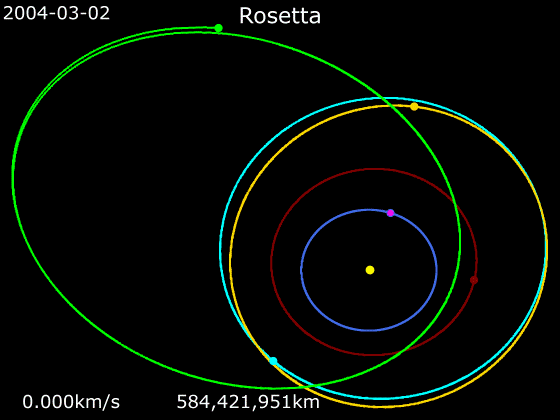|
M-Argo
The Miniaturised Asteroid Remote Geophysical Observer (M-Argo) is a planned space mission by the European Space Agency consisting of a 12U Cubesat that will fly-by an asteroid. Development The ''M-Argo'' is 36.5cm wide and 22cm tall and will contain payloads to determine if there are any in-situ resources. A Cubesat, ''M-Argo'' was largely made with cheap, standard parts that hundreds of other Cubsats use. The probe was designed by a consortium led by the Luxembourg Space Agency, alongside TICRA, GomSpace, and KP Labs. The ''M-Argo'' has its own propulsion system with twelve tiny gas jets to orientate and adjust its trajectory. Due to the crafts small size several different designs were iterated before the development team decided upon electric propulsion. The ''M-Argo'' is also outfitted with a multispectral imager and laser altimeter as its primary payloads to map the asteroid. The multispectral imager was provided by the Polish firm KP Labs which also contributed AI algorith ... [...More Info...] [...Related Items...] OR: [Wikipedia] [Google] [Baidu] |
KP Labs
KP Labs is a Polish Private Space company based in Gliwice that specializes in data processing that was founded in 2016 by students of the Silesian University of Technology who wished to continue to peruse satellite development after graduation. KP Labs is subsidized by the Polish and European governments as part of the Silesian Aviation Cluster program which seeks to turn Silesia into an Aerospace hub. In 2024 KP Labs received the ESA's Innovation Award. Products Current products include: *Antelope: A computational unit for small satellites that can serve either as an on-board computer, or a data-processing unit. *Oryx: A modular flight software tool for mission control of small satellites to create support drivers for otherwise unsupported hardware. *Leopard: A CubeSat standard data processing unit designed for AI solutions. *Herd: AI powered algorithms for image corrections and data analysis. *Oasis: A single board CubeSat PC/104 ground support panel to run flight software bef ... [...More Info...] [...Related Items...] OR: [Wikipedia] [Google] [Baidu] |
List Of European Space Agency Programmes And Missions
The European Space Agency (ESA) operates a number of space missions, both individually and in collaborations with other space agencies such as Japanese JAXA, U.S. NASA, Chinese CNSA, as well as space agencies of ESA member states (eg. French CNES, Italian ASI, German DLR, Polish POLSA). A staple of the ESA's Science Doctrine is the Cosmic Vision Programme, a series of space science missions chosen by ESA to launch through competitions, similar to NASA's Discovery and New Frontiers programmes. It follows the Horizon 2000 and Horizon 2000+ programmes which launched notable missions such as '' Huygens'' (Titan lander), ''Rosetta'' (comet orbiter and lander), and ''Gaia'' (astrometry telescope). These missions are divided into two categories: "Sun and Solar System", space probes studying the Solar System (eg. Solar Orbiter studying the Sun and JUICE currently on its way to Jupiter) and "Astrophysics", space telescopes contributing to interstellar astronomy (eg. CHEOPS charact ... [...More Info...] [...Related Items...] OR: [Wikipedia] [Google] [Baidu] |
European Space Agency Logo
European, or Europeans, may refer to: In general * ''European'', an adjective referring to something of, from, or related to Europe ** Ethnic groups in Europe ** Demographics of Europe ** European cuisine, the cuisines of Europe and other Western countries * ''European'', an adjective referring to something of, from, or related to the European Union ** European Union citizenship ** Demographics of the European Union In publishing * ''The European'' (1953 magazine), a far-right cultural and political magazine published 1953–1959 * ''The European'' (newspaper), a British weekly newspaper published 1990–1998 * ''The European'' (2009 magazine), a German magazine first published in September 2009 *''The European Magazine'', a magazine published in London 1782–1826 *''The New European'', a British weekly pop-up newspaper first published in July 2016 Other uses * * Europeans (band), a British post-punk group, from Bristol See also * * * Europe (other) * The Europ ... [...More Info...] [...Related Items...] OR: [Wikipedia] [Google] [Baidu] |
Phys
Physics is the scientific study of matter, its Elementary particle, fundamental constituents, its motion and behavior through space and time, and the related entities of energy and force. "Physical science is that department of knowledge which relates to the order of nature, or, in other words, to the regular succession of events." It is one of the most fundamental scientific disciplines. "Physics is one of the most fundamental of the sciences. Scientists of all disciplines use the ideas of physics, including chemists who study the structure of molecules, paleontologists who try to reconstruct how dinosaurs walked, and climatologists who study how human activities affect the atmosphere and oceans. Physics is also the foundation of all engineering and technology. No engineer could design a flat-screen TV, an interplanetary spacecraft, or even a better mousetrap without first understanding the basic laws of physics. (...) You will come to see physics as a towering achievement of ... [...More Info...] [...Related Items...] OR: [Wikipedia] [Google] [Baidu] |
Rosetta (spacecraft)
''Rosetta'' was a space probe built by the European Space Agency that launched on 2 March 2004. Along with ''Philae'', its lander module, ''Rosetta'' performed a detailed study of comet 67P/Churyumov–Gerasimenko (67P). During its journey to the comet, the spacecraft performed flybys of Earth, Mars, and the asteroids 21 Lutetia and 2867 Šteins. It was launched as the third cornerstone mission of the ESA's Horizon 2000 programme, after ''SOHO' Cluster'' and '' XMM-Newton''. On 6 August 2014, the spacecraft reached the comet and performed a series of manoeuvers to eventually orbit the comet at distances of . On 12 November, its lander module ''Philae'' performed the first successful landing on a comet, though its battery power ran out two days later. Communications with ''Philae'' were briefly restored in June and July 2015, but due to diminishing solar power, ''Rosetta'' communications module with the lander was turned off on 27 July 2016. On 30 September 2016, the ''Rosett ... [...More Info...] [...Related Items...] OR: [Wikipedia] [Google] [Baidu] |

